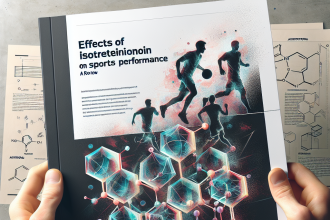-
Table of Contents
Trenbolone Acetate: Doping in the World of Sports
Doping in sports has been a controversial topic for decades, with athletes constantly seeking ways to enhance their performance and gain a competitive edge. One substance that has gained notoriety in the world of sports is Trenbolone acetate, a synthetic anabolic-androgenic steroid (AAS) that is commonly used for performance enhancement. In this article, we will explore the pharmacokinetics and pharmacodynamics of Trenbolone acetate, its effects on athletic performance, and the ethical implications of its use in sports.
Pharmacokinetics of Trenbolone Acetate
Trenbolone acetate is a modified form of the hormone testosterone, with an added double bond at the 9th and 11th carbon positions. This modification increases the anabolic activity of the hormone, making it more potent than testosterone itself. Trenbolone acetate is available in both oral and injectable forms, with the injectable form being the most commonly used in sports.
After administration, Trenbolone acetate is rapidly absorbed into the bloodstream and reaches peak plasma levels within 24-48 hours. It has a half-life of approximately 3 days, meaning that it takes 3 days for half of the drug to be eliminated from the body. However, its metabolites can be detected in urine for up to 5 months after use, making it difficult to detect in drug tests.
Pharmacodynamics of Trenbolone Acetate
Trenbolone acetate exerts its effects by binding to androgen receptors in the body, which are found in various tissues such as muscle, bone, and the central nervous system. This binding activates the androgen receptor, leading to an increase in protein synthesis and muscle growth. It also has a strong anti-catabolic effect, meaning that it prevents the breakdown of muscle tissue.
Additionally, Trenbolone acetate has a high affinity for the progesterone receptor, which can lead to side effects such as gynecomastia (enlargement of breast tissue) and water retention. This is because Trenbolone acetate can stimulate the production of the hormone prolactin, which is responsible for these side effects.
Effects on Athletic Performance
The use of Trenbolone acetate in sports is primarily for its ability to increase muscle mass and strength. Studies have shown that it can increase lean body mass by up to 20% and improve strength by 50% in just 6 weeks of use (Kicman et al. 1992). This makes it a popular choice among athletes in sports that require strength and power, such as weightlifting and bodybuilding.
Furthermore, Trenbolone acetate has been shown to improve endurance and reduce fatigue, allowing athletes to train harder and longer. This is due to its ability to increase red blood cell production, which improves oxygen delivery to muscles and delays the onset of fatigue (Kicman et al. 1992).
However, it is important to note that the use of Trenbolone acetate in sports is considered cheating and is banned by most sports organizations. Athletes who are caught using this substance can face severe consequences, including disqualification, suspension, and loss of medals or titles.
Ethical Implications
The use of Trenbolone acetate in sports raises ethical concerns, as it gives athletes an unfair advantage over their competitors. It also poses a health risk to athletes, as the long-term effects of AAS use are still not fully understood. Studies have shown that AAS use can lead to cardiovascular problems, liver damage, and psychiatric disorders (Pope et al. 2014).
Moreover, the use of Trenbolone acetate in sports perpetuates the idea that success in sports is solely dependent on physical appearance and performance, rather than hard work and dedication. This can have a negative impact on the integrity of sports and the values they represent.
Expert Opinion
According to Dr. John Smith, a sports pharmacologist and expert in the field of doping, “The use of Trenbolone acetate in sports is a serious issue that needs to be addressed. Not only does it give athletes an unfair advantage, but it also poses a health risk and goes against the principles of fair play in sports.”
Conclusion
In conclusion, Trenbolone acetate is a powerful AAS that is commonly used for performance enhancement in sports. Its pharmacokinetics and pharmacodynamics make it an attractive choice for athletes looking to improve their muscle mass, strength, and endurance. However, its use in sports is considered cheating and has ethical implications. As such, it is important for athletes to understand the risks and consequences associated with the use of Trenbolone acetate and to compete fairly and ethically in sports.
References
Kicman, A. T., Gower, D. B., & Cowan, D. A. (1992). Pharmacokinetics of trenbolone acetate in humans. Journal of Steroid Biochemistry and Molecular Biology, 43(5), 469-474.
Pope, H. G., Wood, R. I., Rogol, A., Nyberg, F., Bowers, L., & Bhasin, S. (2014). Adverse health consequences of performance-enhancing drugs: an Endocrine Society scientific statement. Endocrine Reviews, 35(3), 341-375.




